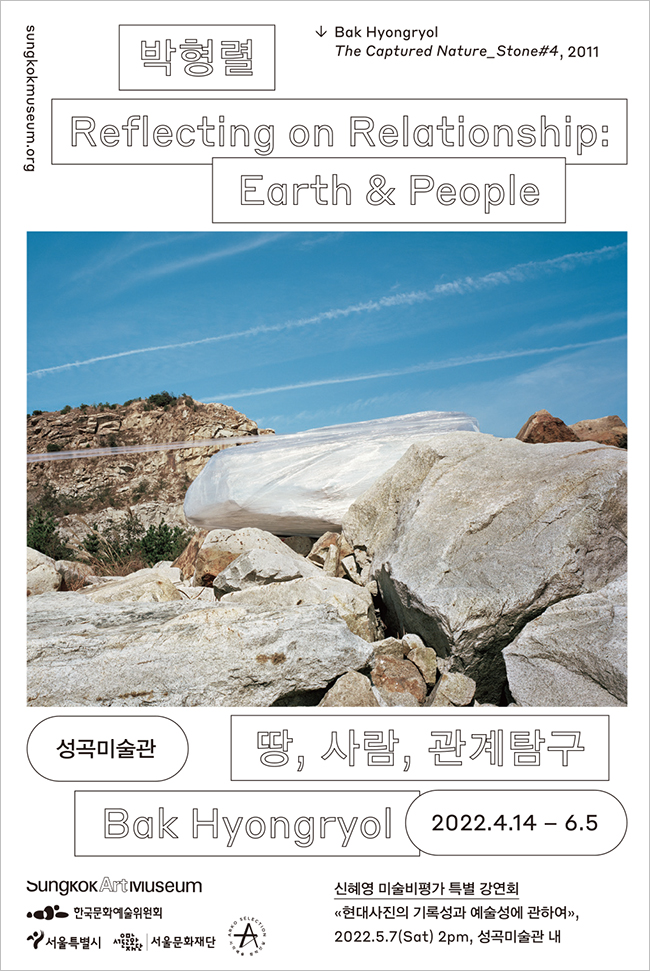땅, 사람, 관계탐구
Reflecting on Relationship: Earth & People
박형렬
Bak Hyongryol
2022년 4월 14일 – 6월 5일
성곡미술관 1관(제 1, 2, 3 전시실)
평일 및 주말 오전 10시 – 오후 6시
* 매주 월요일 휴관
** 입장 마감 오후 5시 30분
전시정보
현시대 한국 사회의 ‘땅’은 누군가에겐 기회의 공간이며, 또 다른 누군가에겐 좌절과 무력함의 공간이다. 생존의 터전인 동시에 투기의 대상인 ‘땅’을 둘러싼 다양한 층위의 방법론과 논리가 존재함에도 땅을 소유하고 변형하는 것, 심지어 보호하는 것마저 인간의 의지에 달렸다는 전제는 변하지 않는다. 땅을 향한 수없이 많은 욕망이 맞부딪히는 지금, 박형렬은 대한민국에서 ‘땅’을 사유한다.
박형렬(Bak Hyongryol, 1980~)은 스스로 ‘별 볼 일 없는 땅’이라고 명명한 대지를 찾아 나선다. 개발과 이윤의 논리가 지도마저 바꿔버린 서해안 간척지, 아직 아무도 찾지 않지만 개발을 목전에 둔 수도권의 땅, 인간의 욕망으로 사라져 이제는 기록으로만 남겨진 산과 평야. 박형렬의 작업은 자본의 논리에 갇혀버린 이 땅에 뿌리를 내린다.
그가 반듯하게 파낸 흙더미 아래, 커다랗게 남아있는 기하학적인 상처는 구조화된 도시를 은유한다. 가까이 다가가면 비로소 층층이 쌓아 올린 도시의 지도 밑에 깔려, 개발을 위해 뿌리 뽑히고 파헤쳐진 본래의 자연이 그 존재를 드러낸다. 폭력적인 진실의 역설 앞에서 박형렬은 파헤쳐진 땅을 다시 덮고 보듬으며 작가의 개입을 치유의 행위로 전환시킨다. 인간의 개입으로 드러난 땅을 찰나의 순간으로 포획하여 시점을 바꾸고 변형을 가하는 등 사진의 조형적 요소를 활용해 그만의 방식으로 전유함으로써, 박형렬의 대지는 비로소 닫힌, 완결된 예술로 자리매김한다.
박형렬이 그리는 대지는 이미 역사 속에 들어와 버린, 인간과 수없이 많은 관계를 맺어 온 땅이다. 간척지나 개발 직전 땅의 모습을 ‘형상’이라고 명명한 행위는 단순한 자연경관의 표현을 넘어 감정을 더한 대상의 모습을 담아낸 것이다. 작가가 모래사장 위에 설치한 색색의 셀로판지는 인간의 무차별한 욕망에 의해 변형된 미래 계획의 섬뜩한 청사진을 연상케 하고, 눈사람을 만들 듯 거대한 땅덩이를 굴리는 사람들은 자신들의 유희를 위해 자연을 훼손시키고 결국 함께 파멸에 이르는 인류의 미래를 예견하는 것처럼 보인다.
우리의 대지를 회복하고자 치유의 퍼포먼스를 펼치는 박형렬의 작업을 통해 땅이 내는 아픔의 소리에 연민을 느낄 수 있기를 바란다. 이번 전시는 ‘성곡 내일의 작가상’을 수상한 박형렬 작가의 초대전으로 작가의 지난 10년을 함께한다.
Information
In contemporary Korean society, the “earth” is a space of opportunities for some, but also a space of frustration and impotence for others. The premise that owning and transforming the earth and even protecting it depends on the will of humans remains unchanging despite the existence of various levels of methodology and logic concerning the “earth” as a base for survival and at the same time an object of speculation. In the present, when countless forms of greed for land conflict with each other, Bak Hyongryol contemplates the meaning of the “earth” in Korea.
Bak aims to seek out land that he refers to as “insignificant earth.” Reclaimed land on the west coast of Korea, where the entire map was changed in pursuit of development and profits, land in the Seoul metropolitan area that is yet unwanted but hovers on the verge of development, and mountains that have disappeared due to mankind’s desire and remain only in records. Bak’s work takes root in such soils where the logic of capitalism overflow across the land.
Underneath the soil that he piled up neatly, the earth cowers with countless scars from iron knives. The artist refers to the vast, geometrical cuts left on the earth, a metaphor for structured cities, as violence. The rich figurative aspect of the pieces of land produced by Bak immediately attract viewers to the works, but what they truly face before their eyes is the immense violence hidden in the beautiful pictures. As they approach closer, nature, which has been buried under the map of a city built up in layers, finally reveals its existence as its essence has been uprooted and dug up in the name of development. Facing the paradox of this violent truth, Bak transforms the artist’s involvement into an act of healing by covering and embracing the excavated earth once more. In this process, the photographs in Bak’s work expand to an artistic medium beyond a simple form of record. Bak’s photographs record the in-between period it takes to choose land, perform the aforementioned act of healing, and at last restore the land to its original state by covering the land with soil again. This alludes to the artistic act of the artist who seeks to capture images of land that will soon disappear and land that has already disappeared and no longer exists. Bak’s earth is only truly established as closed and completed works of art through his photographs.
The earth depicted by Bak is a land that has already entered into history and numerous relationships with humans. In the photographs of the earth that are riddled with human desire, indwell the artist’s affectionate eyes as he gazes at the broken relationship between nature and humans. This exhibition as part of the museum’s program ‘Sungkok Artist of Tomorrow’ encompasses the past decade of the artist's works.


